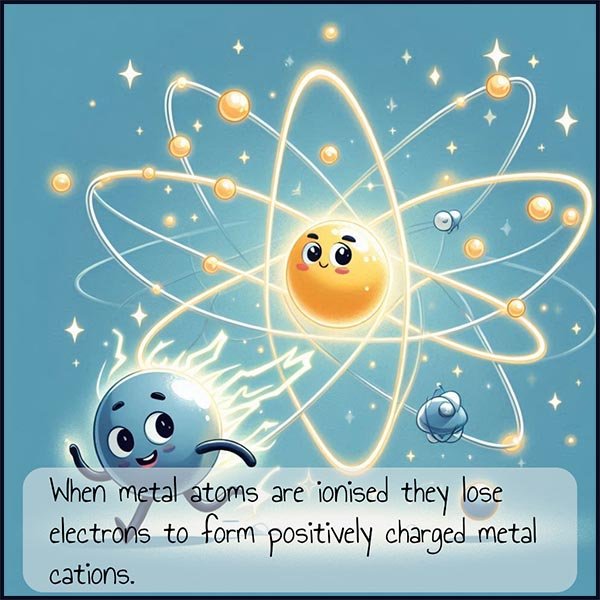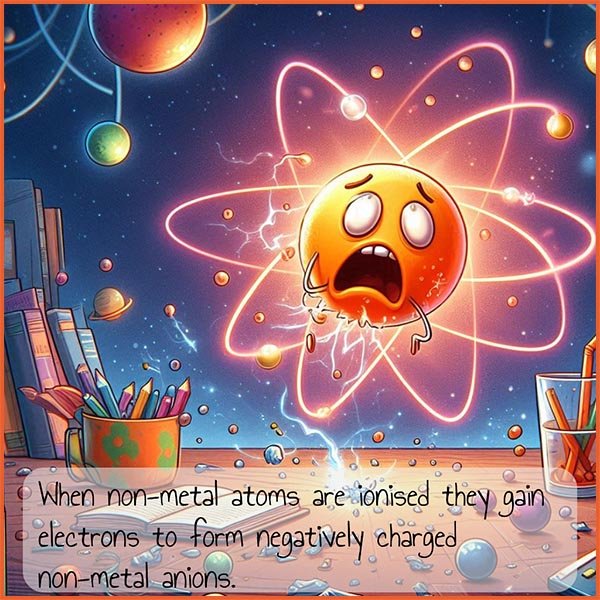Ion formation and electron configurations
Metal Ions and electron configurations

Metals atoms lose electrons
when they react with non-metals such as chlorine, oxygen or bromine to form metal cations, that is an ion
with a positive charge.
As you might expect the electrons are lost
from outer valence electron shell; for example a group 1 alkali metal such as sodium will lose an its 1s electron to form a sodium cation Na+. The three equations below show how the three metals sodium (Na), calcium (Ca) and aluminium can form metal cations by losing electrons.
Na: ( 1s22s22p63s1) sodium loses
its outer 3s1 electron →
Na+(1s22s22p6)
Ca: [Ar]4s2 calcium loses
its outer 4s2 electrons →
Ca2+([Ne]3p6)
Al: [Ne]3s23p1 aluminium loses
its outer 3s2 and 3p1 electrons
→ Al3+ (1s22s22p6 or simply [Ne])
Non-metal ions and electron configurations

Metals from groups I, II and III in the periodic table may generally lose electrons when they react to positively charged metal cations but non-metals from groups 5, 6 and 7 in the periodic table will gain
electrons to form negatively charged non-metal anions; for example the non-metals oxygen and chlorine will gain electrons when they react with metals to form an oxide ion (O2-) and a chloride ion (Cl-) as shown below:
O: (1s22s22p4) oxygen
gains 2 electrons →
O2- ( 1s22s22p6) or [Ne]
Cl ( [Ne]3s23p5) chlorine
gains 1 electron →
Cl- ( 1s22s22p63s23p6 or [Ar])
In all of the examples above the ion formed has a noble gas
electronic configuration, that is ns2p6; where n is the principal quantum number or shell number.
Transition metals and electron configurations
With the transition metals the formation of metal cations
does not quite go as you would expect. When
we were working out the electron configurations for the transition metals
using the AUFBAU principle
the sub-shells or sub-levels filled up in the order:
.................4s 3d that is the 4s sub-shell
was filled before the 3d sub-shell.
However the 4s and the 3d sub-levels are very close in energy and after
the 4s sub-level is filled it actually
becomes higher
in energy than the 3d sub-level due to electron-electron repulsions between the 3d and the 4s electrons. This means that when a transition metal
loses electrons to form a metal cation, the 4s electrons are lost before the 3d electrons.
For example:
Iron forms two common ions, Fe2+and Fe3+.
The electronic configuration of these ions is
shown below:
Formation of Fe2+ ion:
Fe ([Ar]4s23d6) iron
lose 2 electrons →
Fe2+ ([Ar]3d6)
The 2 electrons which are lost
come from the 4s sub-level and NOT
the 3d sub-level.
Formation of Fe3+ ion:
Fe ([Ar]4s23d6) iron
loses 3 electrons →
Fe3+ ([Ar]3d5)
This time the iron atoms lose 3 electrons. Two of these electrons come from the 4s sub-level
and one electron comes from the 3d sub-level.
It is worth noting that the Fe3+ ion has a half-filled
3d sub-level, this will make it more stable
than the Fe2+ion.
Example 2: What is the electronic configuration of the Ti2+ ion?
Ti ([Ar]4s23d2) titanium
loses 2 electrons from the 4s sub-level →
Ti2+ ([Ar]3d2)
Example 3: What is the electronic configuration of the Cr3+ ion?
Recall that one of the transition metals with a slightly unexpected electronic configuration is chromium; now chromium has a half-filled d sub-shell and
1 electron in the 4s sub-level.
So the electronic configuration of the Cr3+ ion is:
Cr ([Ar]4s13d5) chromium
loses 3 electrons, two from the 3d sub-level
and 1 from the 4s sub-level →
Cr3+:[Ar]3d3
Electron Configuration Practice
Practice questions and quick quiz
Next



